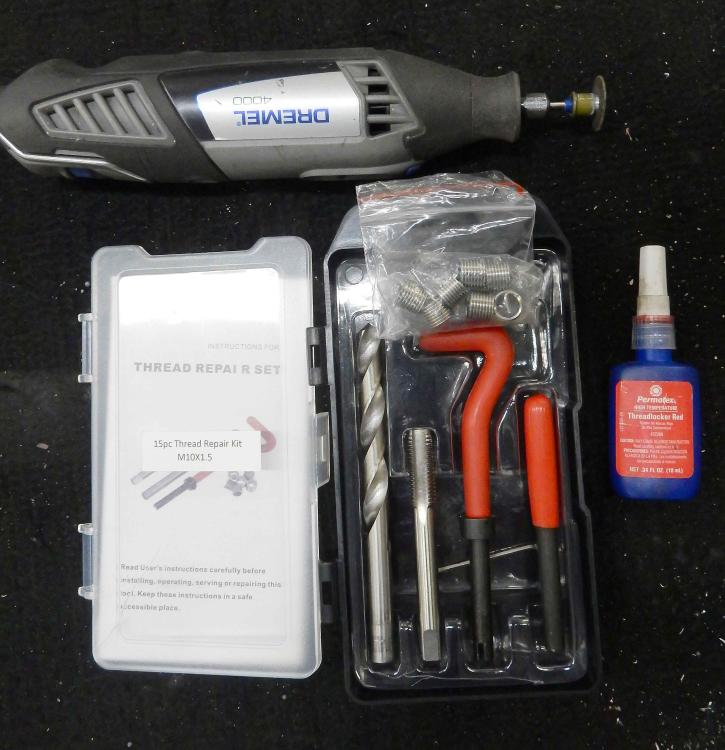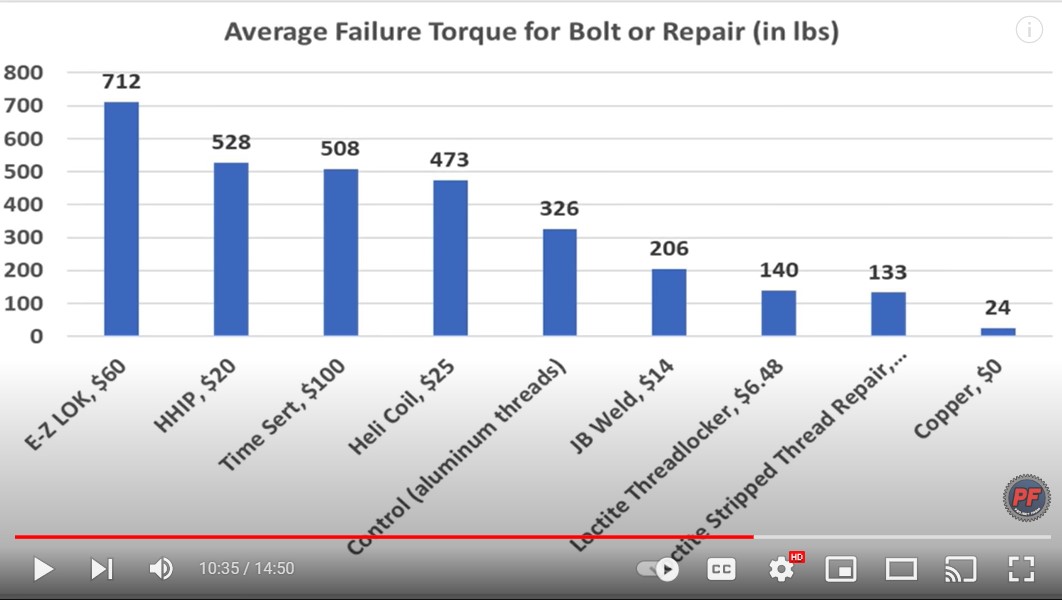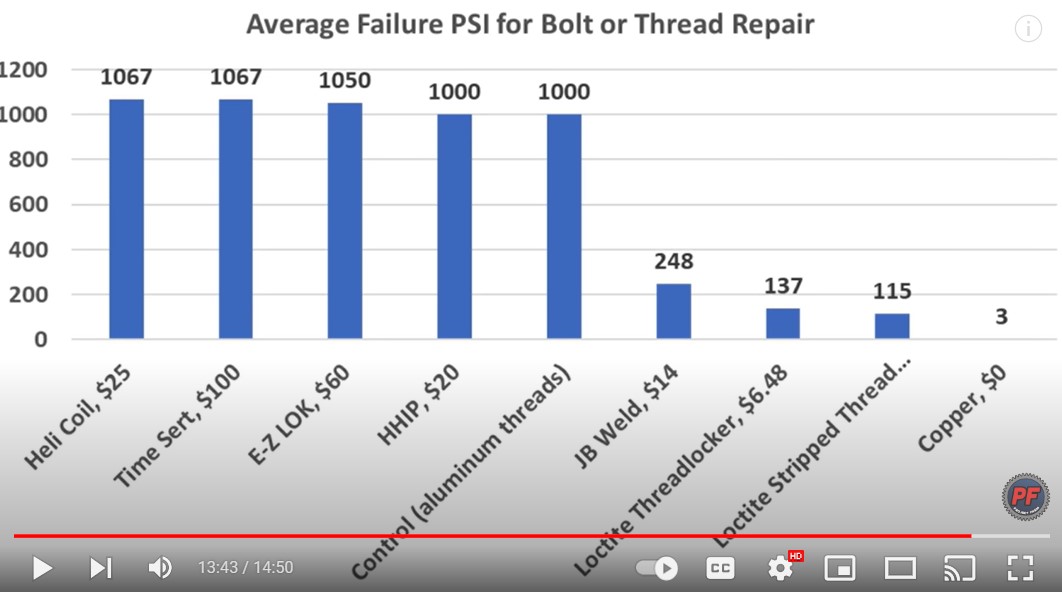Helicoil Learnings
|
Administrator
|
I've used Helicoils before, but today I had a few learnings that I want to record so I'll remember them. And maybe it'll help others as well. (I'll move this to Resources & How-To's after everyone has had a chance to see it.)
I bought the kit shown below from Amazon and it worked nicely, but I also used the Dremel and red Loctite as well as a drill, although it isn't shown. However, the inserts are too long for the rear seat bolts in the floor. At first I thought I could thread the insert all the way in and then break off the tang, leaving the excess coil protruding below the floor pan. But that didn't work as the unsupported coil absorbed the shock of trying to break the tang, and deformed the coil.  Then I spent an hour trying to cut or break the excess turns on a new coil off, to no avail. The metal in the coil is very springy and HARD, and that was a fruitless exercise. Finally I installed the coil and went under the truck with the Dremel and that cutoff wheel and cut the excess off. No need to break the tang, no need to shorten the coil ahead of time, just cut it off afterwards.  Last, there was the learning on Loctite. Initially I put it on the outside of the coil but after installing the coil there was a lot of Loctite inside the coil, which might have caused problems with the bolt. But on the 2nd coil I put the Locktite on the threads in the truck and it didn't migrate to the inside. So there you have it, what I learned today - cut the excess off with a Dremel and put the Loctite on the part the insert is going into.  
Gary, AKA "Gary fellow": Profile
Dad's: '81 F150 Ranger XLT 4x4: Down for restomod: Full-roller "stroked 351M" w/Trick Flow heads & intake, EEC-V SEFI/E4OD/3.50 gears w/Kevlar clutches
|
|
Administrator
|
Allow me to learn you further.....did you know that the heli-coil was a highly regarded secret during WWII?
John
"Blackie" - 1986 F150 4x4 - Mildly warmed over 351W HO - Original owner |
|
Administrator
|
I didn't know that! Now I feel smarter.

Gary, AKA "Gary fellow": Profile
Dad's: '81 F150 Ranger XLT 4x4: Down for restomod: Full-roller "stroked 351M" w/Trick Flow heads & intake, EEC-V SEFI/E4OD/3.50 gears w/Kevlar clutches
|
|
Gary, your post made me intrigued about different ways/brands of taping bolt threads.
Found this interesting video on YouTube.
Jeff / 1984 F350 Crew Cab 4x4/5.8L w351 4V/ T18/ D50 4.10 front/ 8' bed.
Restored 2019-2022. Nicknamed «Big Brother 1984», due to its soooo-looong shape & nod to George Orwell's 1984 famous novel. |
|
Administrator
|
In reply to this post by Gary Lewis
 Thank you for sharing Gary Thank you for sharing Gary
SHORT BED 4-DOOR DIESEL: 1986 F350 4x4 under construction-- 7.3 IDIT ZF5+GVOD
STRAIGHT SIX 4X4: 1981 F150 2wd to 4x4-- 300 I6 close ratio diesel T19, hydroboost brakes, Saginaw steering BIG F: 1995 F-Superduty under construction— converting to 6.9L IDI diesel ZF5+DNE2 |
|
Administrator
|
In reply to this post by BigBrother-84
Welcome, Jonathan.
Jeff - That is a really interesting video. That guy always does thorough work, and I'm impressed with this test like all the rest. I've put the major results below, and can draw one easy conclusion using the chart on the right: When testing the strength of the bolt, if you have enough threads even aluminum provides more holding power than the bolt. And the range of holding power from 1000 to 1067 psi was surely just the variation in the strength of the bolts used. But I'm not sure what to conclude on the torque test. The bolt twisted off when testing all four thread repair kits (E-Z Lok, HHIP, Time Sert, & Heli Coil), leaving the threads from the kit intact. So why was there a difference of 473 to 712 in-lbs? It looks like the bolts failed just below the head, so might the variation have been to do with the surface of the aluminum block? The guy wasn't using a washer, so the head was rotating against the aluminum block.  However, I think it is fair to say that even the Chinese HHIP kit, which appears to be the one I used, provides very strong threads.  
Gary, AKA "Gary fellow": Profile
Dad's: '81 F150 Ranger XLT 4x4: Down for restomod: Full-roller "stroked 351M" w/Trick Flow heads & intake, EEC-V SEFI/E4OD/3.50 gears w/Kevlar clutches
|
I agree, I had the same doubts about the torque test... Although one thing is clear, don't rely on "copper trick" or Loctite for serious repair!  Yep, these "sleeve" kits are surprisingly strong! And, in order to secure vehicle seats to the floor, the torque issue isn't the main concern in case of accident... The bolt not tearing out is the goal! 
Jeff / 1984 F350 Crew Cab 4x4/5.8L w351 4V/ T18/ D50 4.10 front/ 8' bed.
Restored 2019-2022. Nicknamed «Big Brother 1984», due to its soooo-looong shape & nod to George Orwell's 1984 famous novel. |
|
Administrator
|
Very true. And from what I've read the inserts provide more strength than normal threads. Perhaps that's because the inserts have a larger external thread in the base metal, which provides more strength.
Gary, AKA "Gary fellow": Profile
Dad's: '81 F150 Ranger XLT 4x4: Down for restomod: Full-roller "stroked 351M" w/Trick Flow heads & intake, EEC-V SEFI/E4OD/3.50 gears w/Kevlar clutches
|
That makes sense. The contact surface is more important between the inserts and the "host" metal, larger circumference, more threads length. A larger bolt hangs better than a smaller one, and the insert acts as a larger bolt does. Not sure this hypothesis holds up, but I like it! 
Jeff / 1984 F350 Crew Cab 4x4/5.8L w351 4V/ T18/ D50 4.10 front/ 8' bed.
Restored 2019-2022. Nicknamed «Big Brother 1984», due to its soooo-looong shape & nod to George Orwell's 1984 famous novel. |
|
Administrator
|
Torque tests can be very inconclusive as thread condition, lubricant etc. can really change things. What you are trying to achieve is a desired clamping force or the point at which the bolt breaks. In the case of seat bolts that are generally loaded in shear, a less ductile grade is desirable. Ford put the seats in our trucks in with the front fasteners on a 45° angle where the rear ones are vertical. In a normal collision, the seat belts are going to take most if not all of the load, but a heavy unrestrained item behind a seat.
As for breaking bolts and torque vs stress on them. In a test I performed for our QID (nuclear inspectors) I used a device called a Skidmore-Whihelm bolt tension indicator which is a hydraulic load cell that the bolt is inserted through and torqued. Lubrication is an eye opener, I was testing 5/8-11 gr 5 bolts, the specified lubricant is Neolube, graphite in isopropyl alcohol. Procedure is apply a coat to both parts, allow to dry fully, then repeat. The question was raised "what if it isn't dry?", at roughly 1/2 the specified torque, the bolts would just stretch apart with almost no effort. Dry, it is a so-so lubricant (works real well on Cub Scout Pinewood Derby cars), wet, it is slippery as goose poop.
Bill AKA "LOBO" Profile
"Getting old is inevitable, growing up is optional" Darth Vader 1986 F350 460 converted to MAF/SEFI, E4OD 12X3 1/2 rear brakes, traction loc 3:55 gear, 160 amp 3G alternator Wife's 2011 Flex Limited Daily Driver 2009 Flex Limited with factory tow package Project car 1986 Chrysler LeBaron convertible 2.2L Turbo II, modified A413 |
|
Administrator
|
Jeff - That was my theory - the OD of the insert is like a larger bolt so will have more holding power.
Bill - I thought you might have some input given your experience. So it might be that some of the inserts were either lubed or smoother? Or the surface of the aluminum was "better"? I would think that the bolt would twist off due to torque at the same ft-lb regardless of insert if all else was equal.
Gary, AKA "Gary fellow": Profile
Dad's: '81 F150 Ranger XLT 4x4: Down for restomod: Full-roller "stroked 351M" w/Trick Flow heads & intake, EEC-V SEFI/E4OD/3.50 gears w/Kevlar clutches
|
|
In reply to this post by Gary Lewis
They do, its the insert being a stronger metal and the fact that your supposed to locktite the insert in place which I have never done on blind holes as when you bottom them out and break the tang off there is no way it is coming unthreaded. I used one on my 351W I had a bolt for the water pump break off in the block I drilled it out went with a helicoil in the OE size and put a insert.
"Old Blue" - '56 Fairlane Town Sedan - 292-4V, Ford-O-Matic transmission, 3.22:1
'63 Belair 2dr sdn - 283-4V, Powerglide transmission, 4.56:1 '78 Cougar XR7 - 351-2V, FMX transmission, 2.75:1 9inch "Bruno" - '82 F150 Flareside - 302-2V, C6 transmission, 2.75:1 9inch, 31x10.50-15 BFG KO2 |
| Edit this page |

